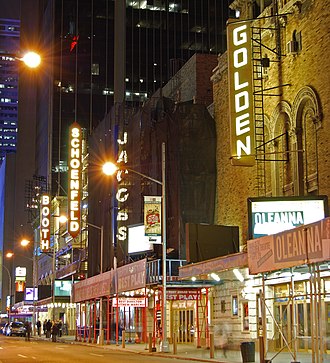
Back Broadway (teater) Afrikaans مسرح برودواي Arabic Circuitu de Broadway AST Брадвейскі тэатр Byelorussian Брадўэйскі тэатар BE-X-OLD Teatre de Broadway Catalan شانۆی بڕۆدوەی CKB Broadway theatre (divadla) Czech Theatr Broadway Welsh Broadway-teater Danish

Broadway theatre,[nb 1] or Broadway, is a theater genre that consists of the theatrical performances presented in 41 professional theaters, each with 500 or more seats, in the Theater District and Lincoln Center along Broadway, in Midtown Manhattan, New York City.[1][2] Broadway and London's West End together represent the highest commercial level of live theater in the English-speaking world.[3]
While the Broadway thoroughfare is eponymous with the district, it is closely identified with Times Square. Only three theaters are located on Broadway itself: Broadway Theatre, Palace Theatre, and Winter Garden Theatre. The rest are located on the numbered cross streets, extending from the Nederlander Theatre one block south of Times Square on West 41st Street, north along either side of Broadway to 53rd Street, and Vivian Beaumont Theater, at Lincoln Center on West 65th Street. While exceptions exist, the term "Broadway theatre" is used predominantly to describe venues with seating capacities of at least 500 people. Smaller theaters in New York City are referred to as off-Broadway, regardless of location, while very small venues with fewer than 100 seats are called off-off-Broadway, a term that can also apply to non-commercial, avant-garde, or productions held outside of traditional theater venues.[4]
The Theater District is an internationally prominent tourist attraction in New York City. According to The Broadway League, shows on Broadway sold approximately US$1.54 billion worth of tickets in both the 2022–2023 and the 2023–2024 seasons. Both seasons featured theater attendance of approximately 12.3 million each.[5]
Most Broadway shows are musicals. Historian Martin Shefter argues that "Broadway musicals, culminating in the productions of Rodgers and Hammerstein, became enormously influential forms of American popular culture" and contributed to making New York City the cultural capital of the world.[6]
Cite error: There are <ref group=nb> tags on this page, but the references will not show without a {{reflist|group=nb}} template (see the help page).
- ^ Pincus-Roth, Zachary (February 8, 2008). "Ask Playbill.com: Broadway or Off-Broadway—Part I". Playbill. Archived from the original on March 24, 2020. Retrieved August 14, 2022.
- ^ Viagas, Robert (December 16, 2015). "Hudson Theatre Will Be Reopened as Broadway House". Playbill. Archived from the original on August 14, 2022. Retrieved August 14, 2022.
- ^ Naden, Corinne J. (2011). The Golden Age of American Musical Theatre: 1943–1965. Scarecrow Press. p. 1. ISBN 9780810877344. Archived from the original on April 25, 2023. Retrieved November 9, 2020.
- ^ "How to Tell Broadway from Off-Broadway From..." Playbill. Playbill, Inc. January 13, 2019. Archived from the original on October 21, 2019. Retrieved February 28, 2020.
- ^ "Broadway Season Statistics". The Broadway League. Retrieved August 3, 2024.
- ^ Martin Shefter (1993). Capital of the American Century: The National and International Influence of New York City. Russell Sage Foundation. p. 10. ISBN 9781610444972. Archived from the original on April 25, 2023. Retrieved November 20, 2015.